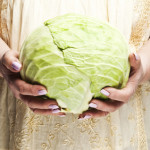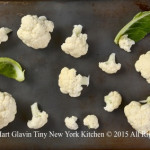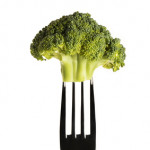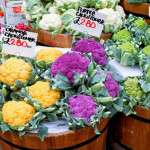Lucky Foods For New Year’s Day
This New Year’s make a resolution to bring yourself a heaping helping of good luck. It’s as easy as just making dinner.
In cultures around the world, the new year is celebrated with particular foods and recipes thought to bring good fortune. Symbolizing wealth, long life, and prosperity, lucky foods are an auspicious and delicious way to celebrate the holiday and welcome good things in the coming year.
Pork & Sauerkraut
Tender braised pork, along with other forms of pork (like sausages and roasts) is a symbol of abundance in Celtic and Chinese cultures, and is popular amongst the Pennsylvania Dutch on New Year’s Day. Paired with the cabbage in sauerkraut, a Chinese symbol of wealth and prosperity, this easy braise with apples and onions is one tasty pot of good luck.
Black Eyed Peas, Greens & Cornbread
Traditionally eaten in the South on New Year’s Day, this trifecta of ingredients represents three different types of money. Leafy greens represent dollar bills, the round peas symbolize coins and cornbread is the color of gold.
Grapes
According to Spanish lore, eating 12 grapes as the clock chimes midnight on New Year’s Eve will bring you 12 months of good luck. Incorporate this tasty tradition by adding grapes to your holiday cheese board or dessert platter. Or try a delicious side dish with savory sautéed Brussels sprouts, grapes, and crunchy walnuts.
Pomegranates
In Greece, smashing a pomegranate on the floor to release the seeds is a surefire way to bring good luck. The seeds represent abundance and fertility. The more seeds you see, the luckier you’ll be. Instead of smashing, sprinkle that good fortune over peak season oranges, mixed greens, and prosciutto for a colorful celebration of a salad.
Fish
Fish are thought to represent progress and abundance because they constantly swim forward and group together in schools. In Czech culture, the scales of the fish are considered lucky because they resemble silver coins and if you carry a silver coin in your wallet it is said that your money will never run out. Celebrate the new year abundantly with a fish dish that everyone will enjoy.
Noodles
No Chinese New Year, Lunar New Year, celebration is complete without a bowl of noodles. Symbolizing longevity and health, noodles are always left whole. Breaking or cutting a long strand of noodles is considered bad luck. Nourish a long life with a longevity noodles dish.
Cake
Ring shaped cakes, like Bundt cakes, are a sweet way to celebrate coming full circle from the previous year. In cultures around the Mediterranean, a coin is baked into the cake and thought to bring wealth and good fortune to the lucky recipient who finds it. Bake a delicious ring-shaped cake and be sure to warn your guests if you decide to bake it with a coin hidden inside.
©Tiny New York Kitchen © 2020 All Rights Reserved
Add this Cucumber Cabbage Salad to your Easter or Passover menu. Fresh dill adds bright spring flavor to this crunchy salad.
Beautiful autumn! The tapestry of autumn is tinged with splendor, as nature sheds its robe of green and garbs itself in the richly textured colors of fall. As leaves begin to turn deep shades of burnt orange, russet, gold, umber burgundy, cooks seek out lavish and luscious seasonal ingredients.
Apples
Pears
Cranberries
Persimmons
Pomegranates
Cabbage
Rutabaga
Turnips
Cauliflower
Beets
Sweet potatoes
Pumpkins
Squash
“Work With What You Got!”
©Tiny New York Kitchen © 2018 All Rights Reserved
It’s that time of year again, in America, when the beer turns green and the aroma of corned beef and cabbage fills the air. The dish is so comforting, but just what is corned beef? The term has nothing to do with corn, but was the English term for a small granule, such as a grain of salt. In days before modern refrigeration, salting meat was a way to preserve it and keep it from spoiling.
Corned beef is an Americanized addition to the traditional Irish diet. While colcannon (boiled potatoes, cabbage, and leeks in buttermilk flavored with wild garlic) was a common Irish dish, as was brown soda bread, corned beef was produced primarily for export to England. Upon arriving in America, however, it’s thought the Irish chose to celebrate their holiday with food that was typically not available to them in their home country, so corned beef was added to the menu, as was white soda bread studded with currants and caraway.
Corned beef is typically made from beef brisket, which is a cut of meat from the breast or lower chest, but the rump, bottom round, and even tongue, can be used. In America, the term “corned beef” is used to describe both the cured meat and the canned stuff found on grocery store shelves. In Britain, they call the canned stuff “salt beef.”
To make corned beef the meat is simmered in a blend of corned beef spices that usually include peppercorns, garlic, mustard, tarragon, thyme, parsley, cloves, and nutmeg.
In New England, you most often see corned beef served as a St. Patrick’s Day main dish or in a sandwich. As the main ingredient in New England Boiled Dinner, corned beef often pairs with potatoes, carrots, turnips, and cabbage in a hearty, savory, brothy bowl of goodness. When used in a sandwich, the most popular corned beef sandwich is the Reuben. Considered the quintessential Jewish deli sandwich, a Reuben is toasted rye bread stuffed with hot slices of corned beef, usually piled high, and topped with sauerkraut, Swiss cheese, and either Russian or Thousand Island dressing.
In New England, a frequent point of interest is also whether you prefer red vs. gray corned beef. The difference is “Red” brisket is cured with nitrite, which gives the meat its signature color. “Gray” corned beef, which is considered the authentic New England variety, is not cured with nitrate, so color forms naturally as it brines.
If you have corned beef leftovers a New England favorite is corned beef hash, which is typically served for breakfast.
“Work With What You Got!”
©Tiny New York Kitchen © 2018 All Rights Reserved
The colder months are when a rainbow of fruits and vegetables reach their peak, from dark green kale to sunny citrus.
Jicama
Pronounced hee-cah-ma, this winter vegetable is crunchy and refreshing. Its mild flavor makes it perfect for salads, salsa, or as crudités for your favorite dip. Use a vegetable peeler to remove its tough skin. When chopping, pick the ones with taut skin and firm flesh.
Turnips
This phytonutrient-rich root vegetable becomes sweeter as you cook it, shedding any bitterness along the way. The greens are particularly good for you and make an easy side sautéed with some garlic in olive oil.
Beets
Putt off by the long cooking time for beets? Reach for conveniently precooked packages in the produce section, or enjoy them raw. Peel them and grate them into salads or smoothies.
Parsnips
Earthy, sweet parsnips are loaded with fiber and minerals like folate and potassium. Older parsnips can have a somewhat fibrous core, which you can cut out before cooking if you prefer a softer texture.
Red Cabbage
High In antioxidants, red cabbage is great for slaws, but unlock a whole new world of flavor by sautéing, roasting or even grilling it.
Citrus
This category of fruit is at its peak right now, so take full advantage. The beauty of citrus is that it can swing from sweet to savory. These fruits stay fresh for weeks in the fridge, so keep a variety on hand to brighten up breakfasts, lunches, and dinners. Lemons, limes, and grapefruit are easy-to-find mainstays, but don’t be afraid to experiment with blood oranges, key limes, Meyer lemons, kumquats, pomelos, and clementines.
Brussels Sprouts
Full of fiber and vitamins K and C, this once-maligned cruciferous vegetable (from the same family as cauliflower and cabbage) is way more versatile than you think. Try it raw, roasted, fried, steamed, or sautéed.
Kale
This leafy green has gone from tossed-aside garnish to hot trend to salad staple. Whether you choose the curly or lacinato type, kale is high in vitamins K, C, and A, as well as carotenoids like lutein to promote eye health.
“Work With What You Got!”
©Tiny New York Kitchen © 2018 All Rights Reserved
English Stew (1860)
English stew is the name given to the following excellent preparation of cold meat. Cut the meat in slices, pepper, salt, and flour them, and lay them in a dish. Take a few pickles of any kind, or a small quantity of pickled cabbage, and sprinkle over the meat. Then take a tea-cup half full of water; add to it a small quantity of the vinegar belonging to the pickles, a small quantity of catsup, if approved of, and any gravy that may be set for use. Stir all together and pour it over the meat. Set the meat before the fire with a tin behind it, or put it in a Dutch oven, or in the oven of the kitchen range, as may be most convenient, for about half an hour before dinner-time. This is a cheap, simple way of dressing cold meat.
“Work With What You Got!”
© Victoria Hart Glavin Tiny New York Kitchen © 2016 All Rights Reserved
Buttered Cabbage
Civil War deprivations did not stop women from sharing recipes (receipts) with one another. This recipe for Buttered Cabbage was published in Godey’s Lady’s Book in 1862.
“Boil the cabbage with a quantity of onions, then chop them together, season with pepper and salt, and fry them in butter. It is a rather homely, but savory dish, and frequently used either with fried sausages laid over it or as an accompaniment to roast beef, and forms part of bubble and squeak.”
“Work With What You Got!”
© Victoria Hart Glavin Tiny New York Kitchen © 2016 All Rights Reserved
Cauliflower
Whether roasted, mashed, raw or added to pasta dishes, there’s something so comforting about cauliflower’s mild, creamy flavor. Plus, it’s one of the most nutritious vegetables around. What’s not to love?
Cauliflower is a member of the cruciferous family, along with broccoli, cabbage, and kale. These vegetables are an important part of a heart-healthy lifestyle, high in nutrients and fiber and very low in calories.
It’s easier than you might think to separate a whole cauliflower into florets, but if you’re really pressed for time, take advantage of prepared fresh or frozen cauliflower.
To prep cauliflower you will need to first remove the cauliflower’s leaves and cut out the core. Then break into evenly sized florets, cutting any very large ones. Add to a pot of boiling salted water and cook for about 5 minutes. Drain thoroughly. Rinse with cold water if you plan on using it later.
Cauliflower works great as a replacement for higher starch foods like rice, couscous, and potatoes. Steam and mash it to replace potatoes or pulse it in a food processor to create cauliflower “rice” that can be sautéed or steamed and served with curry or chili.
“Work With What You Got!”
© Victoria Hart Glavin Tiny New York Kitchen © 2015 All Rights Reserved
Broccoli
Broccoli is a plant in the cabbage family with tight heads of green, purple, or white flower buds that are cooked and eaten as a vegetable. Broccoli comes from the Latin brachium, “strong arm/strong branch,” and comes from a reference to its shape. Broccoli is the Italian plural of broccoli, “cabbage sprout/head,” and literally means “little shoots.”
When shopping for broccoli look for heads that are dark green or purplish and tightly clustered. The stalks should be fresh looking and not tough or woody.
Refrigerate broccoli for up to five days in a perforated bag. Broccoli can be blanched and frozen for up to 1 year.
To remove dirt simply soak a head of broccoli upside down in a bowl of cold water for 20 minutes. Cut or peel off any stalk parts that are tough. Cut into spears. Broccoli can be precooked by blanching or parboiling.
Eat more broccoli!
Work With What You Got!”
© Victoria Hart Glavin Tiny New York Kitchen
Cauliflower is nothing but cabbage with a college education. – Mark Twain















